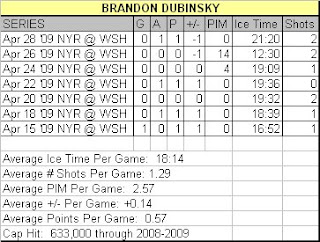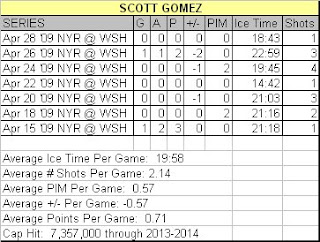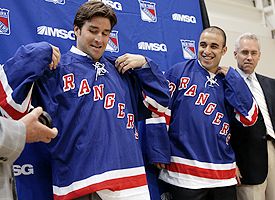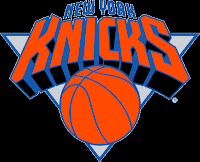 In a league where every team has the same amount of money to spend on their players, it makes it imperative to approach players Contracts with the entire team in mind.
In a league where every team has the same amount of money to spend on their players, it makes it imperative to approach players Contracts with the entire team in mind. Think of building a team like building a house. You have a schematic of exactly how you want it to look. You have a budget set for how much money you can spend. And then you have variables like partnerships, outsource-able contracts, and any personal connections or tricks you may have garnered in the past (which we will get into later).
First you install the 'guts' of the house, like the framework, plumbing and electrical, walls, flooring, and roof. (These 'crucials' can be represented in hockey by low-cost 3rd and 4th line talent. I consider 3rd and 4th line players to be those that leave games having generated more for their team by having given up less. If the third/fourth lines of opposing teams cancel each other out, both teams will have had demonstrated strong foundations. These lines you will find your shut-down players, penalty killers, checkers, and defensive defensemen. Their success can be measured by penalties drawn, penalties killed, time spent in the opposing team's zone, hits delivered, and other intangibles.)
Once the foundation is laid and the guts are working cohesively, then you can think of what kind of counter tops to install, the number of diamonds to encrust on the chandelier, where you'll mount your flatscreen. (In hockey, these are represented by the scoring players, who have proven they are worth the big bucks, and should expect top-line minutes. These are investments that are supposed to shine the brightest, and be the most attractive aspects. However, they must be selected appropriately to work with the foundation -and not against it- as the best hockey teams will feed off one anothers' successes.
Unfortunately for the Rangers, their high-cost luxuries and foundation-crucials have not complimented each other well, and our investments have not lived up to their advertised potential. Our pricey players have not performed up to par, which has caused extra stress on the lower-level foundation guys who then would exhaust their efforts into covering up the top lines mistakes and scoring voids. The '08-09 Rangers were known for their top penalty killing and egregious [thanks Walt Frazier] power play - a clear sign that our blue collar guys were being overworked and our Playboys were casting down more slack to pick up then they were dishing out to their opponents.

The Rangers, possibly after their '06-07 semi-final defeat to the Buffalo Sabres, have since taken an "A-" game, and turned it into a "C+" game. We ended up selling the wide screen TV and pool table (Jagr, Shanahan, Straka, Tyutin) to make room for the bowling alley and bar (Gomez, Drury, Redden). Now we face the problems of not having a TV to watch after experiencing full-HD. Also our house already had a bar out where the pool was (Roszival), which is now struggling to find its position on the team after complimenting the pool so well. We will also need to reconstruct the basement to fit in the bowling alley, which demands a lot more money to maintain and operates a lot differently then a pool table.
The team was reconstructed after a semi-successful 06-07 campaign, and then tweaked again last summer. These changes have seen the removal of some of our foundation elements, with some big question marks being inserted into major roles. The end result was a lack of identity, lack of confidence, and absolutely a lack of scoring.


Brandon Dubinsky and Scott Gomez are fine examples for the point I am trying to make. Similar production, with perhaps a tiny bit proven scoring in Gomez [but not by much] and +/- in Dubinsky. And to whoever watched the '08-09 playoffs, a lot more intangible goodness in Dubinsky that sets the organization up for success.
Brandon Dubinsky has been a reliable foundation player, offering "more good then bad" for this team, satisfying his original purpose as a 3rd line center. Dubinsky was drafted by the Rangers, did his time in Hartford and fought for his position like his career depended on it (which it did). Dubinsky's salary was based off his draft position, and his expiring $633,000 contract will need upgrading and renewing for the coming years.
Scott Gomez was a free agent acquisition and the result of an [expected] bidding war amongst other luxury-hungry teams. Scott Gomez was handed a 7-year deal worth $7,357,000 million a year without ever having played a game for the Rangers. Gomez does not need to prove anything or fight for his spot on the roster. It is not a necessity to his future with his team. This is not a new concept, however, and has always been a cause for concern when new faces are given huge long-term contracts. Gomez's [and Drury's] lackluster performances this season are a result of a 'good player' being forced into a 'superstar' role, while the sturdy floorboards of the team have begun to disintegrate.
Dubinsky has proven value as a + (positive) player, having been nurtured by the Rangers organization, and driven by ice time - not dollar signs.
Gomez has shown signs of brightness, but has not shined like the franchise player he has been paid to be, and absolutely has not been a positive influence on the framework of the Rangers shanty.
 Scott Gomez and Chris Drury signed on July 1st, 2007. Their combined $14,407,000 salary represents 15% of the roster's total payroll ($58,295,000). Lump in other big-bucks-no-lucks players Michal Roszival and Wade Redden and that combines to $25,407,000 - or 29% of the entire roster's payroll. Throw Lundqvist on there (even though his is the only contract I can actually agree with, seeing as how he earned it), and that makes it $32,282,000.
Scott Gomez and Chris Drury signed on July 1st, 2007. Their combined $14,407,000 salary represents 15% of the roster's total payroll ($58,295,000). Lump in other big-bucks-no-lucks players Michal Roszival and Wade Redden and that combines to $25,407,000 - or 29% of the entire roster's payroll. Throw Lundqvist on there (even though his is the only contract I can actually agree with, seeing as how he earned it), and that makes it $32,282,000.As it stands now, the total of 22 players contracted on a team, will see 5 of them receiving $32,282,000, or 80.1% of the allotted $58,295,000.
6 of these remaining 17 are already on Contract for next year also, albeit shorter term, bringing the total to $42,909,000.
This means we have 9 open roster spots for "foundation" players and one "super-star" if we are going to actually score some goals, and $15,386,000 to spend on them.
I can think of at least two franchise-born Rangers who will be looking for their first big contracts, and rightfully so, Brandon Dubinsky and Ryan Callahan.
We'll have about as much cap space in the off-season as the Caps gave space to our shoulda-beens in the playoffs.






No comments:
Post a Comment